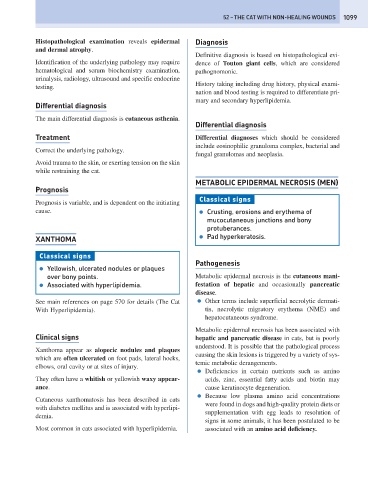Page 1107 - Problem-Based Feline Medicine
P. 1107
52 – THE CAT WITH NON-HEALING WOUNDS 1099
Histopathological examination reveals epidermal Diagnosis
and dermal atrophy.
Definitive diagnosis is based on histopathological evi-
Identification of the underlying pathology may require dence of Touton giant cells, which are considered
hematological and serum biochemistry examination, pathognomonic.
urinalysis, radiology, ultrasound and specific endocrine
History taking including drug history, physical exami-
testing.
nation and blood testing is required to differentiate pri-
mary and secondary hyperlipidemia.
Differential diagnosis
The main differential diagnosis is cutaneous asthenia.
Differential diagnosis
Treatment Differential diagnoses which should be considered
include eosinophilic granuloma complex, bacterial and
Correct the underlying pathology.
fungal granulomas and neoplasia.
Avoid trauma to the skin, or exerting tension on the skin
while restraining the cat.
METABOLIC EPIDERMAL NECROSIS (MEN)
Prognosis
Classical signs
Prognosis is variable, and is dependent on the initiating
cause. ● Crusting, erosions and erythema of
mucocutaneous junctions and bony
protuberances.
XANTHOMA ● Pad hyperkeratosis.
Classical signs
Pathogenesis
● Yellowish, ulcerated nodules or plaques
over bony points. Metabolic epidermal necrosis is the cutaneous mani-
● Associated with hyperlipidemia. festation of hepatic and occasionally pancreatic
disease.
See main references on page 570 for details (The Cat ● Other terms include superficial necrolytic dermati-
With Hyperlipidemia). tis, necrolytic migratory erythema (NME) and
hepatocutaneous syndrome.
Metabolic epidermal necrosis has been associated with
Clinical signs hepatic and pancreatic disease in cats, but is poorly
understood. It is possible that the pathological process
Xanthoma appear as alopecic nodules and plaques
causing the skin lesions is triggered by a variety of sys-
which are often ulcerated on foot pads, lateral hocks,
temic metabolic derangements.
elbows, oral cavity or at sites of injury.
● Deficiencies in certain nutrients such as amino
They often have a whitish or yellowish waxy appear- acids, zinc, essential fatty acids and biotin may
ance. cause keratinocyte degeneration.
● Because low plasma amino acid concentrations
Cutaneous xanthomatosis has been described in cats
were found in dogs and high-quality protein diets or
with diabetes mellitus and is associated with hyperlipi-
supplementation with egg leads to resolution of
demia.
signs in some animals, it has been postulated to be
Most common in cats associated with hyperlipidemia. associated with an amino acid deficiency.

